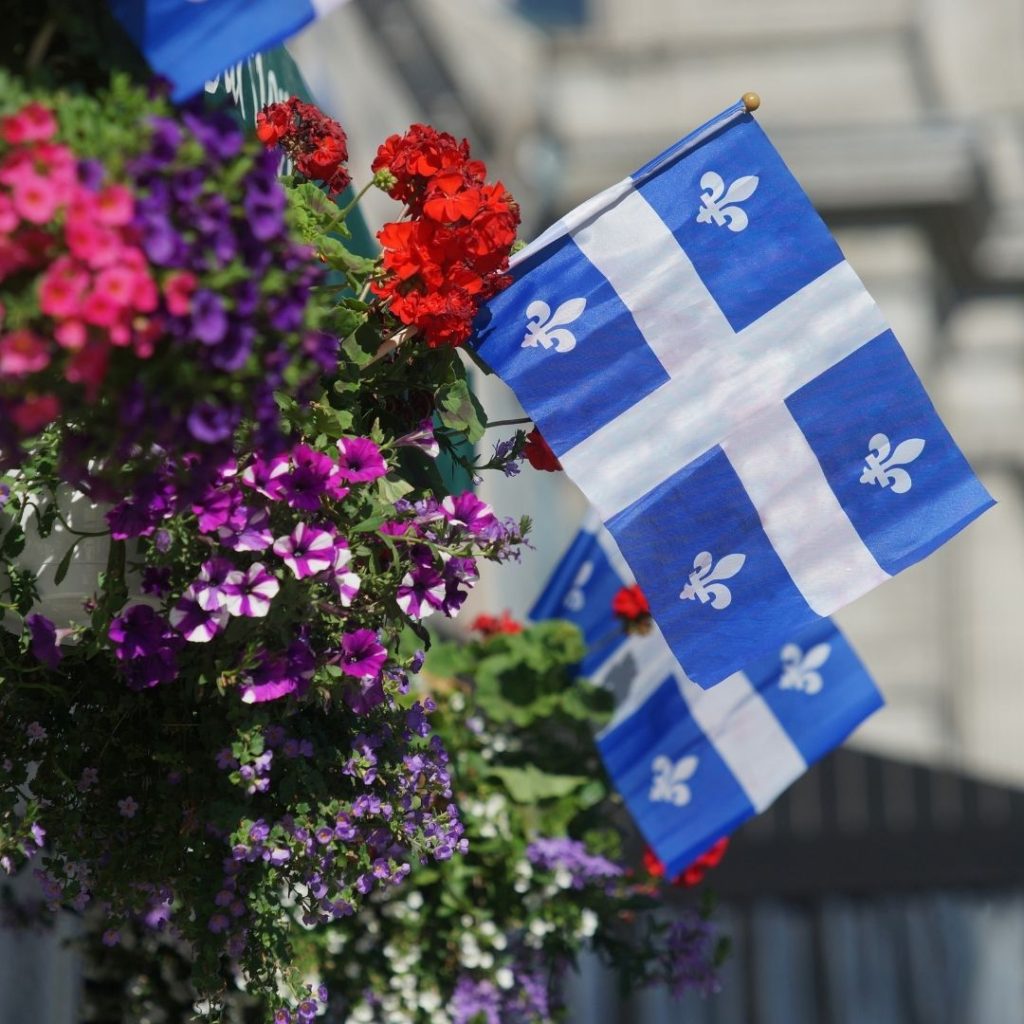
La Fête Nationale – 2021 Guide to Quebec’s Largest Celebration
Everything You Need to Know About Canada’s Saint-Jean-Baptiste Day, or “The National Holiday of Quebec”
As our lives teeter closer and closer to the brink of “back to normal,” more and more people are making travel plans for the future. However, despite our eagerness to fling the door open and greet the post-pandemic world with open arms, several significant events are still being held online. One such event is Quebec’s Saint-Jean-Baptiste Day, known by the Francophone community as La Fête Nationale.
Though the festival will be held virtually for the second year in a row, the event’s online livestreams offer more accessibility for those of us who are curious about Quebec’s history and annual traditions. At first glance, La Fête Nationale appears to be one big party clad in blue and white, but observing the history and traditions behind this holiday may provide non-Quebecers with the context they need to celebrate like the locals!
What’s the History Behind Saint-Jean-Baptiste Day?
La Fête Nationale is observed as a holiday and celebrated in the province of Quebec, alongside a few smaller Francophone communities dispersed across Canada. Canadians have been celebrating on this date for centuries; prior to June 24th being made into a patriotic holiday, festivities on this day were often performed to celebrate the summer solstice — an ancient pagan tradition. However, the French Catholic church later transformed this long-standing tradition into a celebration of Saint Jean, an ascetic Jewish prophet prevalent in the Christian faith.
For centuries to follow, Saint-Jean-Baptiste Day was simply a religious holiday — but one man wanted to make the festivities an expression of French-Canadian pride while showing religious faith. In 1834, a French-Canadian businessman named Ludger Duvernay visited a Saint Patrick’s Day celebration in Montreal. He thought the celebration of Saint Patrick’s Day was a great way to express Irish pride and wanted to bring the same sort of celebration to French-Canadians. Inspired by what he’d seen, Duvernay then formed the Saint-Jean-Baptiste Society and worked alongside numerous influential people to make Saint-Jean-Baptiste Day a province-wide holiday.
The Saint-Jean-Baptiste Society finally succeeded in 1925, and Saint-Jean-Baptiste Day was recognized nationally as a statutory holiday. In recent decades, the focus of Saint-Jean-Baptiste Day has shifted from purely religious and patriotic to a celebration of culture and unity among Quebecois, giving the holiday a more secular connotation. Because of this significant change, the officially recognized name of the holiday is La Fête Nationale, though the two names are still used interchangeably by many French-Canadians.

How is La Fête Nationale Celebrated Today?
Though the Fête Nationale has gone through several changes throughout its long history, lots of traditions have withstood the test of time and are still conducted today! The holiday has continued to acknowledge its pagan roots, as fires are an important part of the festivities.
The night before the celebration, French-Canadians light over 300 bonfires, perform dances, and sing traditional folk songs. Embers from fires lit on National Aboriginal Day held on the 21st of June, are used to light the bonfire in Quebec City on the night of the 23rd.
Lots of celebrations are conducted the night before La Fête, but the next morning is when the party really starts: extravagant parades and concerts are held in the streets for large crowds, with live musical guests hailing from all across Canada and sometimes internationally.
Though musical genres vary, a staple song that you may hear during the celebration is Gilles Vigneault’s “Gens du pays,” which has been performed for the Fête Nationale since the 1970s. Since then, the song has become synonymous with provincial pride among French-Canadians. One volunteer group even organized a “Gens du pays” sing-along event in June of 2020, where Quebecois would stand out on their balconies and sing Vigneault’s song into the streets from the comfort and safety of their own homes.
How Has COVID-19 Impacted the Fête Nationale festivities?
Other creative means of celebration have also come into effect in the wake of the pandemic: this year, the Fête Nationale Facebook page hosted a children’s drawing contest, where kids from across the province sent in their best drawings of what they consider a “tight-woven Quebec,” despite the less-than-ideal circumstances. Some of the more traditional ceremonies include a virtual flag-raising event, where ten fleurdelisés are raised in the city square to honor Quebec and its people. A morning mass is also held every year in the church to commemorate Saint-Jean-Baptiste and his contributions.
The effort to make La Fête Nationale an inclusive event for all French-Canadians has also resulted in celebrations that center around minority communities: several LGBTQ+ performers created Saint Jeanne in 2020, a virtual performance that celebrated underrepresented Quebecois identities. The name combines the French masculine word “saint” with the feminine “Jeanne” to break through the strict gender binary that is included in the French language. Saint Jeanne aimed to celebrate Quebec and its people, while still remaining critical of Quebec’s conservatism.
How Can I Celebrate Saint-Jean-Baptiste Day Safely?
This year’s festival may be held online due to complications with COVID-19, but it’s still considered a national holiday. Banks, post offices, and public transit systems are either closed or operate on limited schedules on the 24th, giving you the perfect excuse to curl up with some delivery poutine and watch the festivities from home. Restaurants and food trucks in populated areas like Montreal or Quebec City usually offer deals for Saint-Jean-Baptiste Day, making it the perfect holiday to test out a fair share of Quebec’s signature foods.
Poutine is traditionally made with meat-based gravy, but new restaurants in hip neighborhoods within Montreal have expanded their selection to include vegetarian and vegan options.
Though poutine is the most famous Quebecois food by a landslide and can be enjoyed by just about everyone, carnivores tend to indulge in smoked meat, one of Montreal’s lesser-known specialties.
La Fête Nationale du Québec is Quebec’s largest province-wide celebration, organized by thousands of volunteers annually. The Quebecois’ motivation to maintain a positive atmosphere for 2021’s festivities shows just how much this celebration means to them, and how important it is to Canadian culture as a whole.

The French Language is at Your Fingertips with Pimsleur!
We can all agree on this: the hardest part of learning a new language is actually SPEAKING it.
The good news is, once you connect your tongue with your thoughts, fluency isn’t so hard to achieve after all. Learn how to speak French with Pimsleur and take your conversational Spanish to the next level!
Give us 30 minutes a day and we’ll have you speaking your new language in no time. That’s all it takes for you to confidently inquire about prices, order dinner, ask for (or offer) directions – in your new language – with a near-native accent. Just listen, respond and learn to converse in … Spanish while driving … Japanese while jogging … French while cooking. It’s really that portable and flexible. So what are you waiting for?
When it comes to building actual conversational skills, nothing compares to the proven Pimsleur Method.
Enjoy a Free 7-Day Trial with unlimited access to the Full Pimsleur Premium French Course! Afterward, pay as you go from $19.95 /month.
No Comments for "La Fête Nationale – 2021 Guide to Quebec’s Largest Celebration"